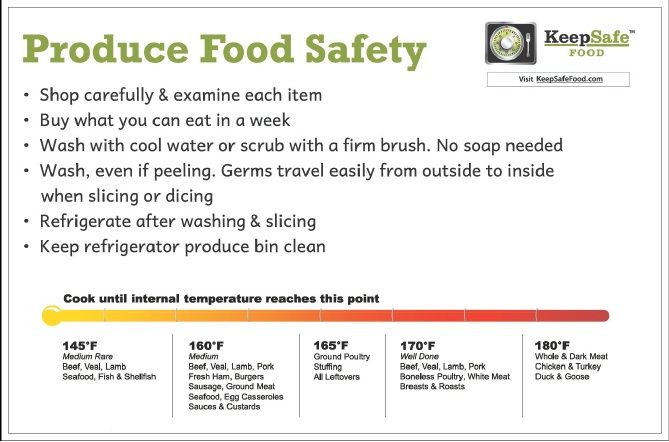Wash, Rinse, Scrub... Repeat?
Guest Blogger Caroline O’Connor gives produce a workout.
I’ve gone down many paths when it comes to cleaning fruits and veggies. Scald with hot water, rinse under cold, wash with soap and water, gently rub, annihilate with a scrub brush... or no water (not cleaning them at all, OOPS!) You name it, I’ve done it. All to prevent food poisoning.
Why? Well, produce is “dirty.” To remove said dirt, clean. Clean = Soap + Water. Honestly, it never made sense to me why I would apply chemicals to healthy produce, all because of a little dirt. I would rather eat dirt than ingest chemicals; therefore, I continued my habit of not washing my produce justifying it by telling myself that a little dirt never hurt anyone. Besides, if there were some germs, fighting them off would give my immune system a helpful workout.
However, while I might be right that a little “clean” dirt may not do much harm, I learned that some organisms found in dirt and on produce certainly can affect you. Read survivor, Lauren’s, story after eating E.Coli on spinach. FBI Victims' Stories
Incidents like hers have led to all kinds of recommendations for cleaning produce before eating, but how do we decide between rinse and scrub, soap or no soap, and how to sort fact from fiction?
Do not fear! There’s no need to worry because I, myself, am a professional worrier so I did all the work for you. I researched the FDA guidelines and now present to you the most effective tips and tricks for produce safety.
I found that produce safety begins before the groceries even hit your counter. In fact, it begins before they even go in your basket or cart! The tips below will provide you with the tools you need to begin implementing proper food safety in your own home.
Choose produce without bruises or damaged spots
For pre-cut/packaged produce, make sure it’s refrigerated or kept on ice.
It might seem wise to wash everything right after you get home. However, it’s best to wait and wash right before you eat it. Moist produce grows more bacteria over time.
When you do wash, wash your hands first.
Rub produce under plain running water. For example, you would take an apple and run it under the faucet while rubbing the skin with your hands.
If the item is to be peeled or cut, such as oranges or tomatoes, clean the outside before slicing. This keeps the knife from transferring dirt and germs from the surface to the inside.
Use a clean brush to scrub firmer produce, like melons or potatoes, with uneven outer skin
For loose leafy greens NOT labeled “pre-washed,” remove the outermost leaves and immerse in a bowl or salad spinner with cold water, toss for 30 seconds, drain and repeat twice.
Dry all produce with clean cloth or paper towel or allow it to air dry
Needless to say, I now feel very confident in my ability to choose, wash and store produce safely; however, it’s helpful to have the guidelines easily accessible for double checking. This produce lover's chopping mat from KeepSafe Food is the perfect kitchen accessory with the guidelines on it for keeping your produce safe and sound while prepping for a meal.
I don’t know about you, but I’ve decided to stop giving my immune system a little “workout,” and start protecting it instead.


